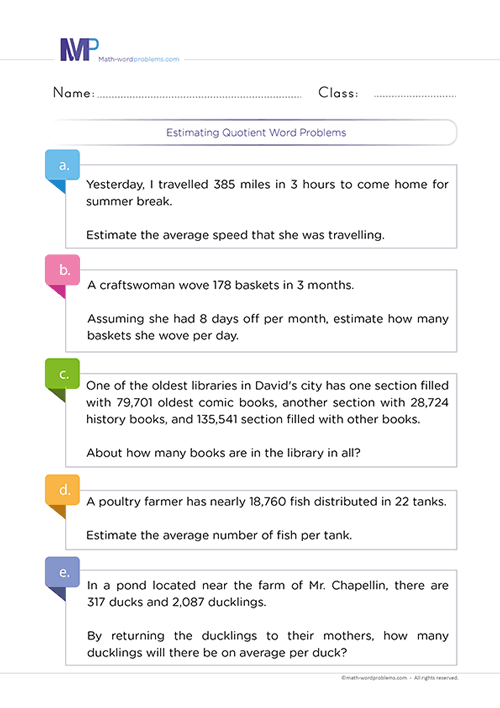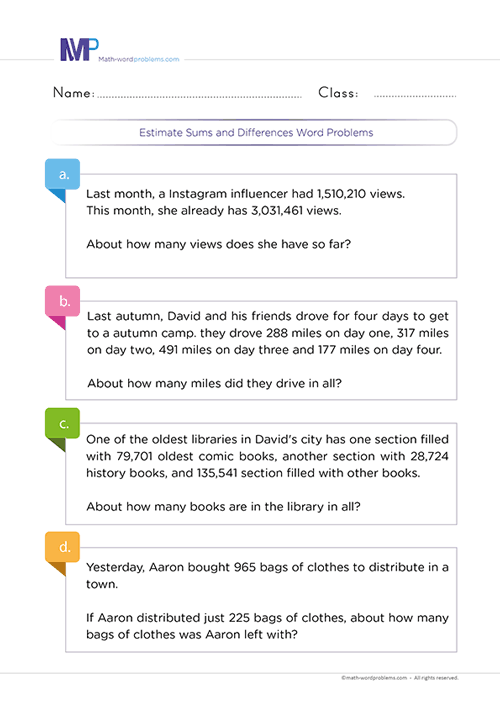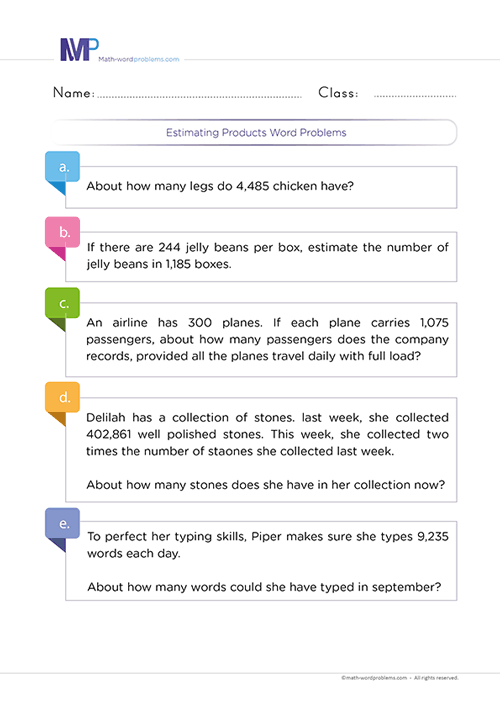 How to estimate quotients word problems
How to estimate quotients word problems
Engage in this guide and explore how to estimate quotients word problems. In a particular way, this guide will take you through the process of estimating quotients with easy, moderate, and complex word problems.
Most importantly, this guide aims to offer 5th graders excellent skills to tackle word problems and estimate quotients using this specially designed and straightforward guide.
After going through this resource, we hope to reduce some common errors your kids usually make when tackling math word problems.
Steps on how to estimate quotients word problems
Hey kids! grab the following steps on how to estimate quotients word problems and obtain amazing quotients estimation skills at an early age.
Here, you'll practice constructing a substantial and coherent mental description containing all solution-relevant components derived from the content base of the word problem.
However, we have added substantial examples to help kids follow these powerful steps below and see how well they work.
Step 1: IDENTIFY THE PROBLEM
To identify the problem, start by finding what the problem wants you to solve. In other words, is the problem asking you to perform a division operation or any other operation? You can do this by looking for the word problem's most important keywords.
- Whenever it comes to estimating whole numbers involving division word problems, you will see at least one of the keywords below: - divide, half, evenly, every, per, parts, out of, quotient of, ratio of, how many in each, equal parts, cut up, average, as much, etc.
- Most importantly, there are two ways to know if a word problem requires you to estimate. If you find the words "about … "and "estimate …" in a word problem, then it is an estimation problem.
In addition, you will apply the concept of compatible numbers toestimate quotients.
Note: One key Element for learners to understand is that they should not always rely on keywords alone. That is to say; the same keyword can have different meanings in different word problems.For this reason, we reiterate on the importance of reading the question very carefully to understand the situation that the word problem is describing, then figure out exactly which operation to use
Step 2: STRATEGIZE OR GATHER RELEVANT INFORMATION
How will you solve or tackle the word problem?
One key thing you should remember is that each word problem may require a different format. Hence, the key points below will enable young math learners to tackle any format however it comes.
- As mentioned above, the keyword(s) in the word problem will enable you to determine if you need to add, subtract, multiply or divide.
- However, know that you must not rely only on keywords. Also, try to understand the situation that the problem is describing.
- Then, after knowing which operation you will perform, construct short expressions/sentences to represent the given word problem.
Step 3: SET UP AN EQUATION
Now, write down a numerical equation representing the information given in the word problem.
Step 4: PROVIDE A SOLUTION
From Step 3 above, estimate and divide the numerical equation. Always add the unit of measurement to the final answer, if any.
* Note that you have to use compatible numbers, which are numbers close to the numbers in question yet can divide one another easily. You can do this by looking for the multiple of the divisor that is close to the last two numbers of the dividend. Then replace the rest of the numbers in the dividend with zeros.
Step 5: CHECK YOUR WORK
Lastly, ask yourself this question. Does my answer make sense? If "YES," you are done. If "NO," go back to step 1 and start all over again.
Examples on how to estimate quotient word problems
Example One
Step 1: Frist, after reading the word problem very well, you see that the important numbers here are 385 and 3. The keyword(s) found in the word problem is "average."
Step 2: Next, how will you solve the problem? The situation that the problem is describing and the keyword calls for you to use a division operation. Also, the phrase "about" shows that we have to estimate.
Now, create short expressions/sentences to represent the given word problem.
- Distance I covered in 3 hours = 385 miles.
- Length of time I used in traveling = 3 hours.
- The average speed that I used in traveling per hour = the distance I covered ÷ the length of time I used
- Therefore, the estimated average speed I used in traveling per hour = the estimated distance I covered ÷ the length of time I used.
Step 3:Now, write down a numerical expression to represent the bolded sentence in step 2 above to solve this word problem:
385 ÷ 3 = ?
Step 4: From Step 3 above, estimate and divide the whole numbers by:
- Use the concept of compatible numbers, i.e., numbers close to the numbers in question, and can easily divide one another.
- You can do this by looking for the multiple of the divisor that is close to the last two numbers of the dividend and then replacing the rest of the numbers in the dividend with zeros.
Let's look for multiples of 3 (divisor) closer to the last two numbers of the dividend and then replace the rest of the numbers with zero.
385 → 3, 6, 9, 12, 15, 18, 21, 24, 27, 30, 33, 36, 39, 42…
You see that 38 is closer to 39. So, replace 38 with 39 and 5 with zero in 385.
385 ÷ 3 ≈ 390 ÷ 3 = 130
So, I traveled at a speed of about 130 miles per hour.
Step 5: Finally, check your work – Ask yourself this question. "Does my answer make sense?" If "YES," you are done. If "NO," go back to step 1 and start all over again.
Example two
Step 1: Frist, the important numbers here are $99,568 and 12(number of days in a month).
Step 2: Next, how will you solve the problem? You see, the word problem does not actually have a keyword, but the situation the problem describes calls for you to perform a division operation. Also, the phrase "about" shows that you have to estimate.
Now, construct short expressions/sentences to represent the given word problem.
- My annual income = $99,568.
- Number of months in a year = 12.
- My monthly income= the annual income ÷ the number of months in a year
- Therefore, my estimated monthly income = the estimated amount of my annual income ÷ number of months in a year.
Step 3:Then, write down a numerical equation for each bolded sentence in step 2 above to solve this word problem:
$99,568 ÷ 12 = ?
Step 4:From Step 3 above, estimate and divide the whole numbers by:
- Use the concept of compatible numbers, i.e., numbers close to the numbers in question, and can easily divide one another.
- You can do this by looking for the multiple of the divisor that is close to the last two numbers of the dividend and then replacing the rest of the numbers in the dividend with zeros.
Let's look for multiples of 12 (divisor) closer to the last two numbers of the dividend and then replace the rest of the numbers with zero.
99,568 → 12, 36, 48, 60, 72, 84, 96, 108…
You see that 99 is closer to 96. So, replace 99 with 96 and 5, 6, and 8 with zeros.
→ $99,568 ÷ 12 ≈ $96,000 ÷ 12 = $8,000
So, my monthly income is about $8,000.
Step 5: Finally, check your work – Ask yourself this question. "Does my answer make sense?" If "YES," you are done. If "NO," go back to step 1 and start all over again.






